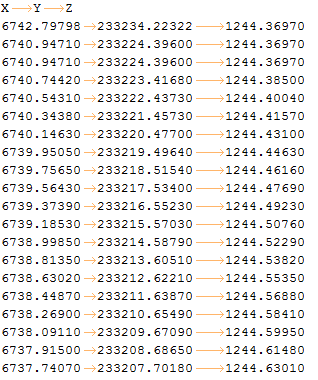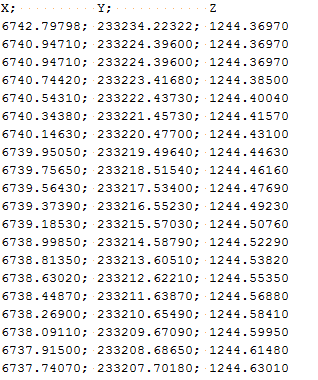

Axis points are defined by importing them from a text file. The text files that can be processed by the Application Server must conform to following formatting rules.
The Application Server tries to automatically detect the character encoding used in the passed text file, it does so by inspecting the files byte order marks (BOM). It automatically recognizes UTF-8, little-endian Unicode, and big-endian Unicode text as well as ASCII text.
The data in the file has to be formatted in rows and columns. Each row (except the header row) describes one axis point. The first column is the X-Coordinate the second column is the Y-Coordinate and the third column is the Z-Coordinate of the axis point. Data in further columns will be disregarded.
The lines must contain the axis points in the right sequence i.e. in the sequence as they define the geometry of the axis.
The column delimiter can be the tab (Unicode U+0009) or the semicolon character (Unicode U+003B). Within one file the same delimiter has to be used. The Application Server auto-detects the used delimiter by inspecting the first line.
The first line in the file is considered to be the header line and is not imported. Lines that cannot be parsed by the Application Server are skipped.
The Application Server provides an Action Log with details about the import.
The strings that describe the numeric values for coordinates X, Y, Z in the source file must conform to following format:
[ws][sign][integral-digits,]integral-digits[.[fractional-digits]][ws]
Elements in square brackets are optional. Table 1 describes each element.
Element |
Description |
ws |
A series of white-space characters. |
sign |
A negative sign (-) or positive sign (+) symbol. |
integral-digits |
A series of numeric characters ranging from 0 to 9 that specify the integral part of the number. Integral-digits can be absent if there are fractional-digits. |
, |
A group separator symbol (Comma) |
. |
A decimal point symbol (Point) |
fractional-digits |
A series of numeric characters ranging from 0 to 9 that specify the fractional part of the number. |
Table 1: Elements in the numeric format.
|
Figure 1: Example of an tab delimited import file. Orange arrows show non-printable tab characters.
|
Figure 2: Example of a space delimited import file. Orange points show non-printable space characters.


